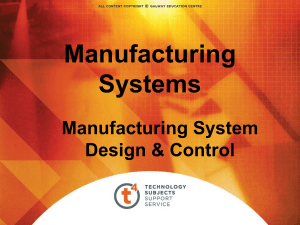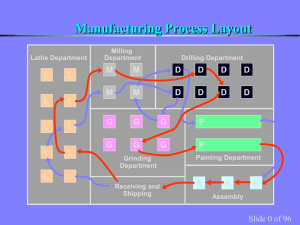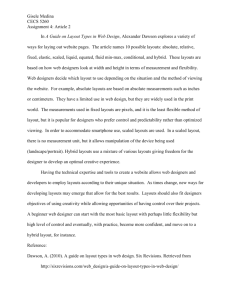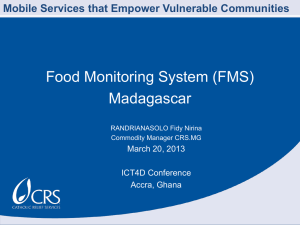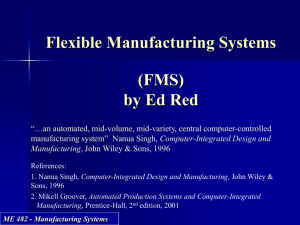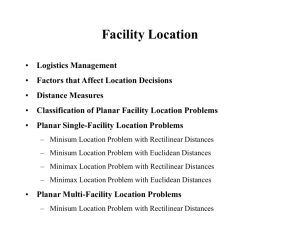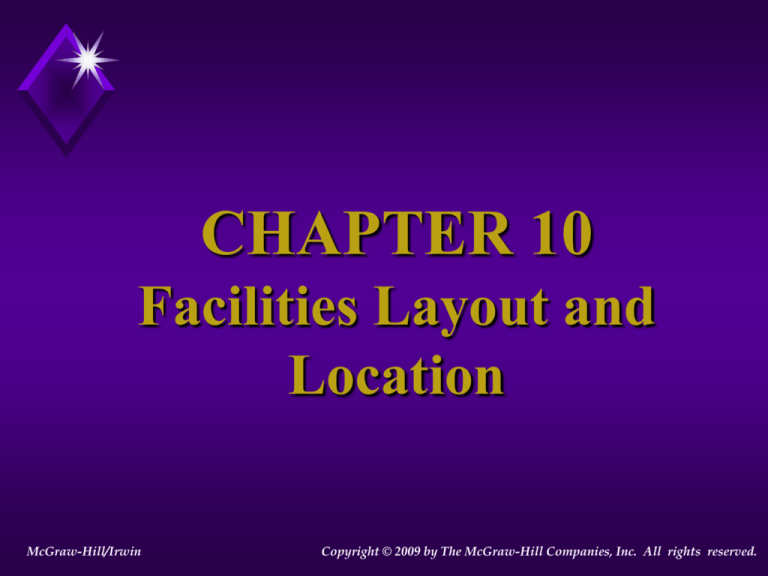
CHAPTER 10
Facilities Layout and
Location
McGraw-Hill/Irwin
Copyright © 2009 by The McGraw-Hill Companies, Inc. All rights reserved.
10-2
Issues in Facilities Design
Minimize investment in new equipment
Maximize production throughput rate
Utilize space most efficiently
Provide for the safety and comfort of employees
Maintain a flexible arrangement
Minimize materials handling cost
Facilitate the manufacturing process
Facilitate the organizational structure
10-3
Patterns of Flow
Straight line flow
U flow
L flow
Serpentine flow
Circular flow
S flow
(refer to Figure 10-1)
10-4
Six Horizontal Flow Patterns
10-5
Activity Relationship Chart
(Rel Chart)
Each pair of operations is given a letter to indicate
the desirability of locating the operations near each
other. The letter codes are:
A: Absolutely necessary
E: Especially important
I: Important
O: Ordinary importance
U: Unimportant
X: Undesirable
(refer to Figure 10-2 for an example.)
10-6
Activity Relationship Chart for
Meat Me Fast-Food Restaurant
10-7
From-To Chart
From-to charts are similar to the mileage
charts on roadmaps. They can show:
Distances separating pairs of work centers
Numbers of materials handling trips between
pairs of work centers
Materials handling costs between pairs of work
centers
(See Figure 10-3 for an example of a From-to distance
chart.)
From-To Chart Showing Distances
Between Six Department Centers
(Measured in Feet)
10-8
10-9
Types of Layouts
Fixed Position Layouts – suitable for large items
such as airplanes.
Product Layouts – work centers are organized
around the operations needed to produce a product.
Process Layouts – grouping similar machines that
have similar functions.
Group Technology Layouts – layouts based on the
needs of part families.
(Refer to the examples in the next four figures)
10-10
Fixed Position Layout
10-11
Product layout
10-12
Process layout
10-13
Group Technology Layout
10-14
Computerized Layout Techniques
CRAFT. An improvement technique that requires the
user to specify an initial layout. Improves materials
handling costs by considering pair-wise interchange of
departments.
COFAD. Similar to CRAFT, but also includes
consideration of the type of materials handling system.
ALDEP. Construction routine (does not require user to
specify an initial layout). Uses REL chart information.
CORELAP. Similar to ALDEP, but uses more careful
selection criteria for initial choosing the initial department
PLANET. Construction routine that utilizes user
specified priority ratings.
10-15
Flexible Manufacturing Systems
An FMS is a collection of numerically controlled
machines connected by a computer controlled
materials flow system. These systems typically are
best for systems with moderately high output and
moderately high need for flexibility.
For low volume high variability systems, stand alone
systems are better, and for high volume, low
variability, fixed transfer lines are better. Refer to
Figure 10-21 to see the environments where FMS
systems are appropriate.
Figure 10-22 shows a typical FMS system.
The Position of FMS
in the Manufacturing
Hierarchy
10-16
10-17
A Typical Flexible
Manufacturing System
10-18
Advantages of the FMS
Reduced work-in-process inventories
Increased machine utilization
Reduced manufacturing lead time
Ability to handle different part
configurations.
Reduced labor costs
10-19
Disadvantages of the FMS
The main problem is cost. Systems cost
upwards of $10 million. They require
upgrading of other related systems (such as
the materials handling system) that can be
equally expensive. There are few cases
reported in the literature that show the
investment in FMS had a reasonable
payback period.
10-20
Facility Location
Goal is to find the optimal location of one or more new
facilities. Optimality depends on the objective used. In
many systems, the objective is to minimize some measure
of distance. Two common distance measures:
Straight line distance (Euclidean distance). The distance
between (a,b) and (x,y) is given by the formula:
( x a ) 2 ( y b) 2
Rectilinear Distance (as might be measured following
roads on city streets).
x a y b
10-21
The Single Facility Rectilinear
Distance Location Problem
Goal: locate n facilities to minimize the weighted
sum of rectilinear distances from the new facility
to existing facilities.
Solution: locate the new facility at the median
location of the existing facilities. This is
accomplished by taking the median location
component by component of existing locations.
10-22
The Gravity Problem
The objective is to minimize the weighted sum of
the squared Euclidean distances of the new facility
to the current facilities. It is an uncommon
problem but has a simple solution.
The optimal solution is that both the x and y
coordinates of the new facility are the ratio of the
weighted x and y coordinates of the existing
facilities divided by the sum of the weights.
10-23
The Straight Line Distance Problem
The objective is to minimize the weighted
sum of the straight line distances of the new
facility to the current facilities.
No simple algebraic solution method exists.
Finding the optimal solution requires an
iterative solution procedure that may begin
with the gravity solution.

